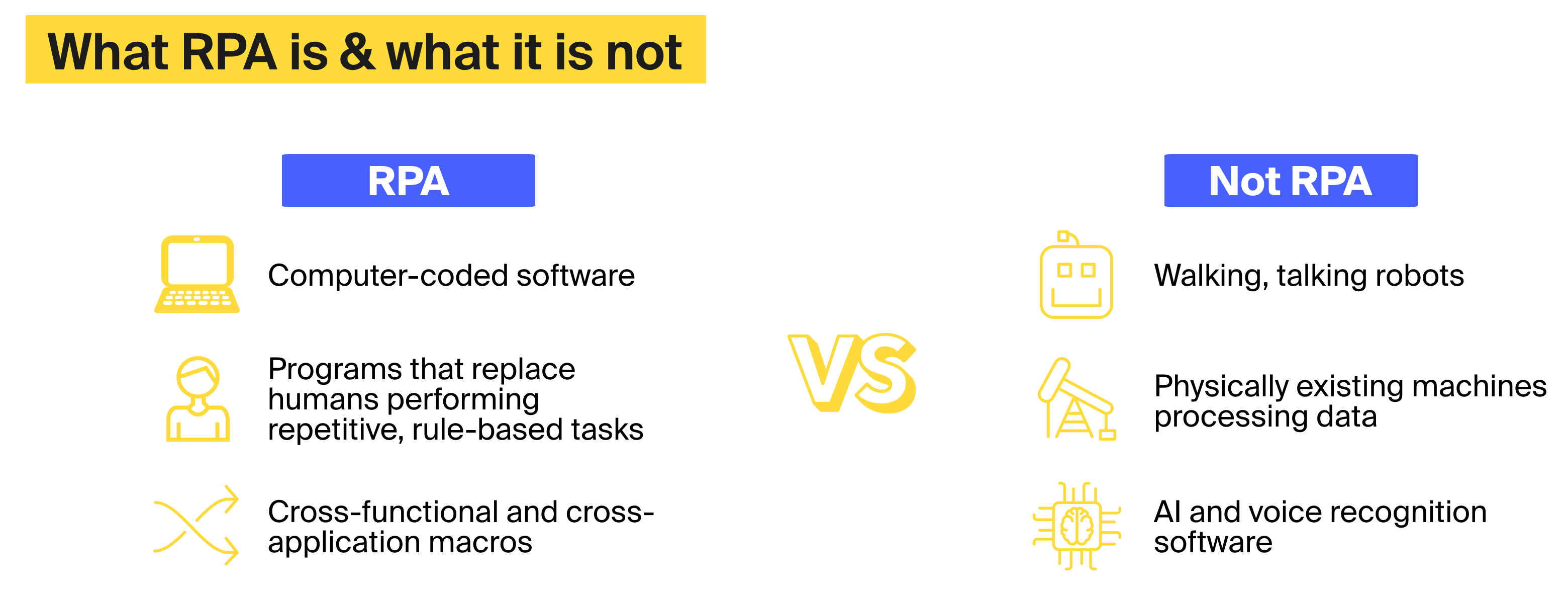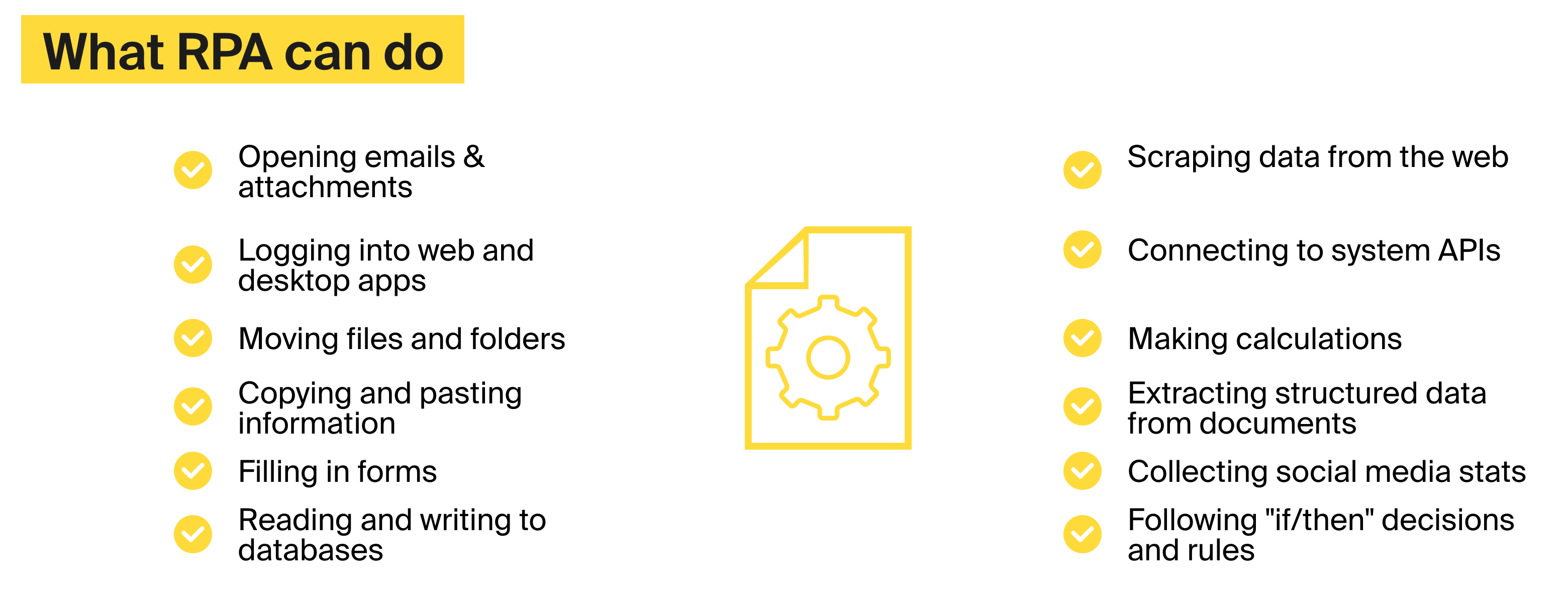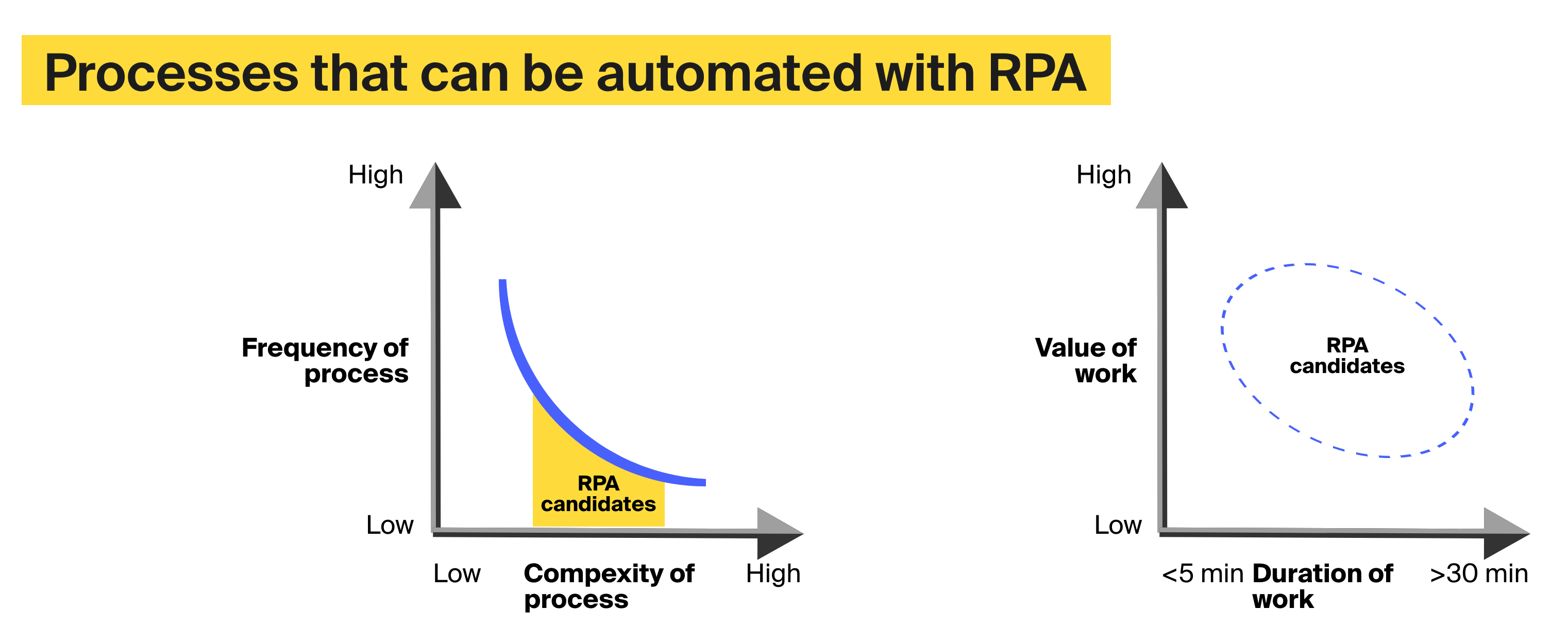Office employees spend around 69 days per year on administrative tasks. This costs US businesses $2.87 trillion in lost productivity annually.
No matter which industry you’re operating in, taking the burden of mundane, rule-based tasks off your employees’ shoulders is always a good idea. And here’s where RPA-as-a-service solutions come in handy.


As of 2020, 72% of companies surveyed by Deloitte had already implemented RPA tools. Improved compliance and quality topped the list of benefits reported by RPA pioneers. At the same time, 59% of enterprises registered a significant RPA-related cost reduction, with the median payback period for RPA projects spanning less than 12 months.
However, only 3% of companies succeed in scaling their digital workforce, while up to 50% of initial RPA projects fail.
Given that robotic process automation costs for a single software bot may range from $5,000 to $15,000, your business might end up spending millions of dollars to achieve company-wide automation.
What are the key factors behind the presumably high robotic process automation cost? Most importantly, what should your company do to realize RPA’s full potential without breaking the bank?
Let’s find that out!
Top five factors driving robotic process automation cost
- RPA vendor pricing
- The number and complexity of bots that constitute your RPA deployment
- Initial process analysis, RPA consulting, and engineering costs
- The cost of third-party robotic process automation integrations
- Maintenance, support, and RPA scaling costs
Below you will find a detailed overview of these factors.
1. RPA vendor pricing models
There are several technology companies offering RPA tools and development platforms on a subscription basis. According to Gartner’s 2021 Magic Quadrant Report for Robotic Process Automation, as well as the Forrester Wave: Robotic Process Automation, Q1 2021 survey, UiPath, Automation Anywhere, and Microsoft Power Automate are the driving forces of the global RPA market, which is set to top $45 billion by 2030.
Let’s see how the leading RPA vendors’ pricing models stack up against each other:
| Estimated RPA pricing | Comments | |
|---|---|---|
| UiPath |
This is an overview of pre-packaged RPA plans helping companies get started with robotic process automation; additional information for enterprise clients is available on demand |
UiPath’s licensing fees depend on the level of automation you’re aiming to achieve. This RPA blog post suggests a single attended UiPath bot would cost your company $1,200-1,800 annually, while unattended bots that require no supervision from your employees cost up to $8,000 per year. The same article reckons UiPath customers pay around $60,000 annually for enterprise-grade RPA deployments. |
| Automation Anywhere |
Although the vendor only shares RPA pricing information upon request, a recent press release from Automation Anywhere specifies that their fees start from $750 per month for the Cloud Starter Pack. Every extra attended and unattended bot adds $125 or $500 to your monthly invoice (respectively). |
Similar to UiPath, Automation Anywhere charges higher fees for fully automated software bots. The number of bots in an RPA deployment is also a significant automation cost factor. When it comes to developer and production Automation Anywhere licenses, your enterprise might end up paying $5,000 and $20,000 in annual fees, respectively. |
| Microsoft Power Automate |
Currently, Microsoft offers three plans for individual users and companies eyeing RPA:
*billed monthly |
Individuals and companies with an Office 365 subscription can start with Power Automate for free. The $15 plan, however, does not contain any RPA functionality. |
In most cases, an RPA vendor pricing model and software deployment mode (cloud-based or on-premises) will determine the cost of an RPA license. For example, cloud-based RPA tools might cost less if bundled, while an on-prem deployment can be cheaper if you choose a long-term commitment.
Typically, vendor licensing fees account for 30% of total robotic process automation costs — or ⅓ of an average salary you’d pay to a full-time employee performing tasks manually.
2. Number and complexity of RPA bots
Robotic process automation tools are not created equal.
For example, we mentioned attended and unattended RPA bots in the previous section. The core difference between the two types of intelligent software agents lies in their ability (or lack thereof!) to perform tasks independently.
It is also necessary to distinguish between business process automation (BPA) and robotic process automation tools; the former merely follow the if-then pattern to automate workflows, while the latter watch your employees interact with software system interfaces and replicate their actions. BPA and RPA have a brighter, more technologically advanced cousin called intelligent process automation (IPA). IPA systems feature machine learning algorithms that retrieve and analyze unstructured data hidden in enterprise IT systems.
The number of bots comprising an RPA system, their cognitive abilities, and the workload they handle are listed among the critical robotic process automation cost drivers.
For instance, a simple RPA bot that converts PDF documents into CSV files may cost your company as little as $25 per month — as long as it processes a few dozens of records over the course of 30 days and does nothing but that. In this case, extra RPA costs may only include a few hours’ worth of maintenance and verification work.
On the contrary, RPA tools that operate within several applications and information systems while checking workflows against multiple conditions require laborious configuration and take longer to implement.
Since the initial cost of robotic process automation might be a heavy burden for small and medium-sized businesses, and ROI perspectives might be too vague to justify the investment, a company should carefully review and analyze processes it is looking to automate. Typically, operations that are performed frequently and take less than 30 minutes to carry out make the best candidates for bot-driven automation.

3. Initial process analysis, RPA consulting, and engineering costs
As far as technology goes, RPA tools do not require brand-new platforms and significant infrastructure upgrades. However, robotic process automation needs sound upfront design and deep knowledge of the processes subject to automation. Otherwise, your RPA deployment will contain configuration errors, which could prevent bots from sourcing information from IT systems and performing tasks effectively.
That’s why most companies eyeing robotic process automation turn to RPA development companies. The vendor of your choice might be a certified UiPath or Automation Anywhere partner. Or a Fortune 500 RPA consulting company like Gartner and Accenture. Or a lesser-known technology company that nevertheless employs skilled robotic process automation engineers.
The RPA company you’d opt for, among other things, will conduct a thorough review of your processes, identify appropriate candidates for automation, and advise on the technology stack. Your technology partner will then devise a high-level RPA architecture and implementation roadmap. Reliable RPA vendors typically adopt an iterative, result-driven approach to automation, creating proof-of-concept (POC) versions of intelligent software agents, training them to perform tasks, fine-tuning their performance, and putting up robust data visualization and reporting tools that make RPA accessible to all employees regardless of their technical background. This approach helps companies get started with RPA in a risk-free manner, achieve ROI faster, and avoid automation overspend.
Depending on the country where your vendor resides, RPA consultants and engineers’ hourly rates may range from $15 to $60 .
4. The cost of third-party robotic process automation integrations
To be able to log into IT systems and access their interfaces, RPA tools must be connected to these systems over APIs. Not surprisingly, the price of all the APIs, applications, and services that give superpowers to a software bot contributes to the overall robotic process automation cost — and not all of those APIs are provided or supported by your RPA vendor by default.
Connecting your bot to AWS, Azure, or Google Cloud services, for example, would incur additional robotic process automation costs that increase proportionally with the amount of data and server calls handled by the bot.
Overall, add-on tools account for approximately 5% of the total RPA costs.
5. Maintenance, support, and RPA scaling costs
Since RPA bots reside in and interact with existing software applications, significant changes made to these systems or the data they produce may trigger RPA reconfigurations and updates too.
Similarly, many companies overlook RPA scaling costs or fall victim to scope creep, trying to expand automation efforts to as many processes and business units as possible or toying with the idea of adding AI capabilities to existing RPA systems.
One way to avoid these problems is to devise a high-level RPA implementation strategy early on. This strategy, among other things, should provision for software dependencies, proactive change management, and stakeholder alignment.
How much does robotic process automation cost? These examples might give you an idea!

RPA solution for patient appointment scheduling
A healthcare technology company turned to ITRex to create an RPA solution for copying patient data from electronic medical records (EMRs) and pasting it to appointment scheduling software. To achieve this goal, we synchronized the two systems and implemented simple scripts that log events and restart processes if an error occurs.
Dzmitry reckons it took two RPA developers approximately eight weeks to devise and deploy the RPA tool. A similar robotic process automation solution would cost you $5,000-10,000. The sum covers actual development efforts and an essential support package. The project involved no licensing fees since we enabled the automation features using custom-written APIs and software agents.
RPA tool for payment processing
A financial organization addressed ITRex to create a robotic process automation system that would process payment information, validate it against bank data, and make the necessary changes to accounting systems and internal reports. The client chose WorkFusion as the primary tech stack, so artificial intelligence agents handled the document processing tasks. For security reasons, we had to deploy the system on premises.
According to Dzmitry, the project team consisted of one project manager, two RPA developers, one machine learning engineer, and one business analyst. The team managed to build a proof-of-concept version of the RPA tool over eight weeks, and it took them six more weeks to roll out the system into production.
Here the cost of RPA implementation would fluctuate around $50,000-150,000 and span RPA vendor pricing, additional infrastructure expenses for server deployment and maintenance, and employee training fees.
RPA document processing system for a telecom company
A telecommunication company partnered with our RPA experts to automate several interconnected document processing and management workflows. Once again, WorkFusion was selected as the primary RPA platform.
A team of three RPA engineers, one project manager, one business analyst, and one project manager completed the project in six months. Considering additional infrastructure configuration and setup expenses, as well as the RPA vendor license fees, a robotic process automation system like this could cost your company $150,000-300,000.
How to reduce RPA implementation costs and achieve ROI faster
According to McKinsey, RPA can bring about a quick and robust ROI — i.e., up to 200% in the first year of deployment — and 20-25% cost savings. Another study by Deloitte suggests that a company that deploys 500 bots at a fully loaded cost of $20 million (including software licenses, planning, process reengineering, programming, testing, and implementation) could potentially realize $100 million in savings, assuming the bots replace 1,000 employees.
Naturally, every RPA instance will come with a different overall budget and cost savings due to unique organizational issues and requirements. However, there are a few things you should keep in mind when considering implementing automation in your organization:
-
Robotic process automation is not a silver bullet solution to your company’s problems; instead, you should treat it as an engine that keeps the wheels of your business turning
-
Implementing RPA does not require you to ditch other IT systems; however, RPA tools should be seamlessly integrated with existing software to source data across your IT infrastructure and interact with target applications the way human employees would
-
It is vital to conduct thorough audits and devise a high-level RPA implementation plan with scalability in mind prior to any development activities since robots are only as good as they’ve been programmed to be
-
Сross-functional teamwork and stakeholder input are the pillars of successful RPA implementation
-
Optimizing business processes before automating them is key to a fault-free RPA rollout
-
A lack of education and awareness around RPA, as well as IT departments’ resistance to change, might prevent your project from taking off
-
Data should be appropriately formatted and optimized for bot-driven manipulation; this problem can be partially solved by implementing AI-based automation tools
Custom robotic process automation tools may cost your company anything between $5,000 and $300,000. The enormous gap between RPA costs is caused by different factors, including the number and complexity of intelligent software agents, vendor pricing, bot configuration requirements, and maintenance efforts. However, when implemented correctly, RPA ensures a relatively fast payback and helps reduce operational costs.
For more information about RPA challenges and ways to overcome them, check out our recent blog post.













